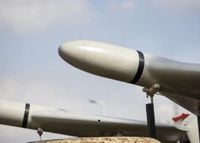In a troubling escalation of hostilities, Russia has significantly enhanced its drone capabilities, deploying modernized versions of Iranian kamikaze drones, the Shahed-136, to terrorize Ukrainian civilians. This development has raised alarms among military experts and Ukrainian officials, who warn of the increased threat these drones pose to the safety of the population.
Yuriy Ignat, the head of the communications department of the Air Force of the Ukrainian Armed Forces, revealed in mid-April 2025 that the new iterations of the Shahed drones are far more sophisticated than their predecessors. "The drones have changed visually, and the enemy has started using composite materials for the fuselage to reduce their reflective surface," Ignat explained. This modification aims to minimize the effectiveness of Ukrainian electronic warfare systems, making these drones harder to detect and intercept.
Moreover, the navigation systems have been upgraded from four antennas for satellite navigation to a significantly larger number, complicating the Defense Forces' ability to counter these aerial threats. Ignat noted that these drones have evolved into tools for scattering deadly traps, leaving behind explosive devices that can detonate unexpectedly. This tactic was first reported in November 2024 in the Sumy region and has reemerged in recent attacks.
On May 1, 2025, during an assault on Kyiv, Yevhen Ievlev, a representative of the Kyiv Military Administration (KMVA), confirmed that Russian drones had scattered cluster munitions capable of detonating under various stimuli such as light, vibration, and heat. "These shells can explode even a day after being dropped," Ievlev stated on the KIEV24 television channel. Military expert Oleh Zhdanov further elaborated on the dangers posed by these drones, stating that the Russians have begun attaching special pipes filled with explosives to the drones. "If a person approaches this pipe, it could lead to severe injury or death," Zhdanov warned.
Despite these alarming reports, there is a lack of official confirmation regarding the use of cluster munitions in Shahed drones. Serhiy Beskrestnov, a military expert specializing in drones and electronic warfare, expressed skepticism, stating that there have never been systems for scattering explosives found in Shaheds. He emphasized that while there may be discussions about the drones' capabilities, concrete evidence of their use in this manner is still lacking.
In addition to the Shahed drones, Ukraine is facing threats from a new type of reactive drone known as the "Banderol." Reports indicate that these drones have been used in attacks across Ukraine, particularly in the Odessa region. On May 5, 2025, the first documented attack involving the Banderol was reported, further heightening concerns.
Information about the Banderol remains scarce, but military analysts suggest it is designed as a barrage munition, potentially capable of reaching speeds between 400 to 500 kilometers per hour. According to Serhiy "Flesh" Beskrestnov, the Banderol can theoretically strike targets at least 200 kilometers away, posing a significant threat to major Ukrainian cities such as Zaporozhye, Kharkiv, and even Kyiv.
Flesh noted that the Banderol's specifications hint at its potential lethality, with a warhead weighing approximately 100 kilograms. "We have long known what we are dealing with, but I cannot disclose information about this UAV before official sources do," he stated.
Despite the growing body of evidence regarding the Banderol, some experts remain skeptical about its existence. Aviation specialist Kostyantyn Kryvolap expressed doubts, stating, "There are strangeness in this whole story. If this drone exists, then where is the evidence? Show us at least one photo of this 'Banderol.'" His concerns highlight the uncertainty surrounding the new drone's capabilities and operational status.
As Russia continues to ramp up its drone production, the Ukrainian military is under pressure to adapt its air defense strategies. Anatoliy Khrapchynskyi, Deputy General Director of an electronic warfare equipment manufacturer, emphasized the need for cost-effective solutions to counter the Shahed drones. "The defense against these drones must be as affordable as possible, given that anti-aircraft missiles are too expensive for daily use," he stated.
In response to the escalating threat, Ukrainian forces have launched strikes against Russian facilities suspected of producing these drones. On April 23, Ukrainian defense forces targeted a manufacturing plant in Yelabuga, where Shahed drones are reportedly produced. However, the outcomes of these strikes have not been publicly disclosed.
Military analysts suggest that the Banderol drone, with its reactive capabilities, may require a different approach for interception. Dmitry Zhmilo, Executive Director of the Ukrainian Center for Security and Cooperation, pointed out that the Banderol shares characteristics with cruise missiles, indicating that it might be intercepted using similar air defense strategies.
Furthermore, Alexander Kovalenko, a military observer, noted that the introduction of these reactive drones could lead to a significant increase in aerial attacks on Ukrainian cities, particularly in southern regions like Kherson and Odessa. He warned that if the testing phase for these drones leads to their widespread deployment, Ukraine could face an unprecedented wave of drone strikes in the coming months.
As the situation evolves, both military and civilian populations in Ukraine remain on high alert, grappling with the persistent threat posed by these advanced drone technologies. The international community watches closely, as the implications of this aerial warfare extend beyond the battlefield, impacting the lives of countless civilians caught in the crossfire.




